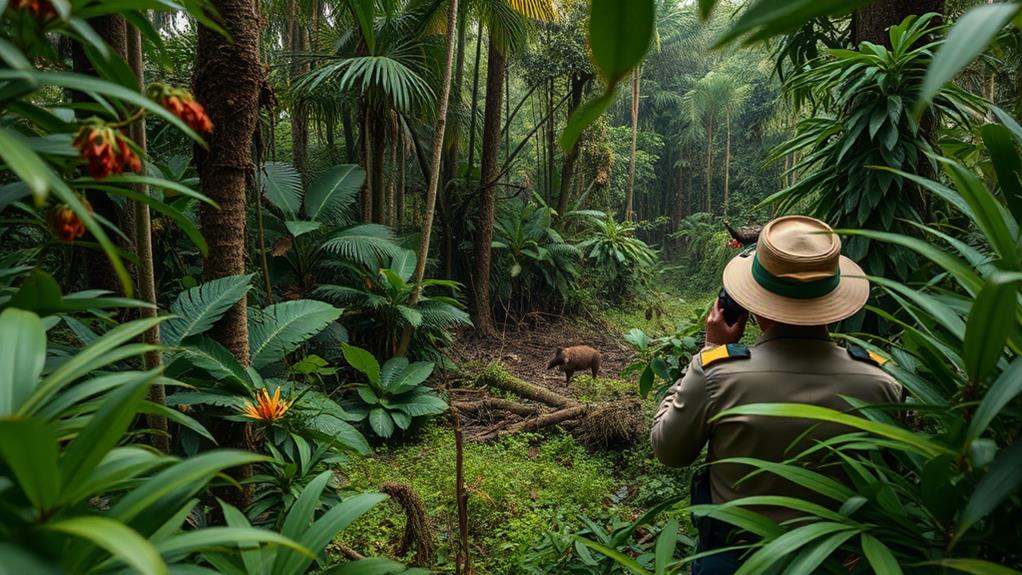Biodiversity conservation is essential for managing natural resources in the Philippines. It maintains ecological balance and provides important services like soil fertility and pollination, which are necessary for farming. For example, healthy ecosystems support crops by ensuring they get nutrients and are pollinated by insects.
Sustainable practices, such as using organic farming methods, can improve local economies and increase resilience to climate change. For instance, communities that practice sustainable fishing can see better fish populations and higher income over time.
However, threats such as illegal wildlife trafficking and deforestation put these benefits at risk. For example, cutting down forests not only removes habitats for animals but also affects water quality and soil health.
Community involvement in conservation efforts is crucial. Local groups can help protect wildlife and promote sustainable practices. Education is also important in raising awareness about biodiversity. Programs that teach people about local ecosystems can lead to better conservation actions.
Overall, understanding the importance of biodiversity and implementing effective strategies is key to ensuring a sustainable future for the Philippines.
Significance of Biodiversity

Biodiversity in the Philippines is essential for the country's health and economy. The Philippines is home to over 20,000 unique species, making it a vital area for biodiversity. However, the loss of about 96% of natural forests threatens these species and reduces biodiversity. This loss disrupts the balance of nature and can lead to problems with food security. Unsustainable fishing practices are reducing fish populations, which harms communities that depend on fish for their livelihood.
Biodiversity is important for many reasons. Ecosystem services like soil fertility, pollination, and climate regulation help manage natural resources. Healthy ecosystems play a big role in agriculture and ecotourism, which together contribute about 15% to the nation's GDP.
Additionally, preserving biodiversity is key to making ecosystems stronger against climate change. Healthy forests and coral reefs can reduce the impact of disasters, protecting both people and nature.
Economic Benefits of Conservation
Conservation in the Philippines provides important economic benefits. By using sustainable practices for managing natural resources, communities can protect the environment while also boosting their economies.
For example, nearly 30,000 people have experienced positive changes in their lives due to effective resource management. The country earns about $100 million each year from timber and non-timber projects. This shows that sustainable practices are valuable for the economy.
Additionally, improvements made over 6 million hectares of land help rural communities grow economically. When locals participate in conservation efforts, they develop sustainable economic practices that benefit both the environment and their communities.
Biodiversity also plays a key role in the economy through nature-based tourism. The unique plants and animals in the Philippines attract many tourists, which helps the national economy.
Threats to Biodiversity

The ecosystems of the Philippines are under serious threat. Illegal wildlife trafficking is a major danger, affecting native species and harming their habitats. For example, the capture and sale of endangered animals like the Philippine Eagle disrupts the balance of nature.
Unsustainable fishing practices also threaten marine life. Overfishing leads to a decline in fish populations, which affects food security for communities that rely on fishing. For instance, coastal towns are struggling as fish become harder to find.
Deforestation is another significant issue. It's mainly caused by agricultural expansion and mining. This loss of habitat puts endangered species, such as the Tamaraw, at greater risk of extinction.
The unique geography of the Philippines makes it hard to enforce laws that protect these areas. Additionally, poor communication infrastructure makes it challenging to report illegal activities like poaching or logging. This delay allows harmful practices to continue.
Without proper management of protected areas and specific actions to combat these threats, the Philippines' biodiversity will remain in danger. Taking action is essential for preserving wildlife and supporting local communities that depend on these ecosystems.
Community Involvement in Conservation
Local communities can greatly influence the preservation of biodiversity in the Philippines. They know how their lives depend on healthy ecosystems. By joining training programs on sustainable practices, community members can help reduce illegal activities that harm wildlife. Including conservation strategies in local development plans helps to align community interests with biodiversity goals, which increases support for conservation efforts.
| Benefits of Community Involvement | Examples of Engagement |
|---|---|
| Sustainable Livelihood Alternatives | Community training on eco-friendly practices |
| Economic Benefits | Over 29,000 individuals positively impacted |
| Respect for Indigenous Knowledge | Working with indigenous groups |
| Enhanced Conservation Efforts | Community goals match biodiversity initiatives |
When local communities are involved, they not only protect biodiversity but also improve economic stability. If local needs are respected in conservation efforts, there will be more support for these initiatives. Your participation can lead to significant positive changes for the environment, benefiting future generations.
Innovative Approaches to Management

Effective biodiversity management uses technology and collaboration to protect natural resources. The B+WISER project shows how advanced monitoring tools can improve biodiversity protection. These tools help create better conservation strategies, especially in protected areas where resources are threatened.
Partnerships between the government, local communities, and businesses are key in improving fire management after wildfires. This teamwork reduces damage and creates a shared responsibility for natural resources.
Additionally, user-friendly technologies help track deforestation in real-time, allowing for quick responses that are vital for forest conservation.
Regularly evaluating and adjusting these conservation methods keeps them effective and sustainable. Combining scientific research with local development plans leads to innovative conservation initiatives that suit specific ecosystems.
Role of Education and Training
Education and training are vital for biodiversity conservation in the Philippines. Communities receive 216,744 hours of training in natural resource management, highlighting the need for knowledge to promote sustainable practices. These training sessions focus on climate change awareness and preparedness, allowing participants to adapt to environmental challenges.
Capacity building occurs at both national and sub-national levels, ensuring that forest management strategies align with local and national conservation goals. This approach helps communities act in ways that support broader efforts to protect the environment.
Disaster-risk reduction programs have also been improved through education, which makes communities more resilient to natural disasters.
Partnerships with various groups strengthen these training programs. By working together and sharing knowledge, stakeholders achieve better conservation results.
Law Enforcement Challenges

Enforcing biodiversity laws in the Philippines is challenging due to the country's many islands. The archipelagic geography makes it hard to patrol areas and enforce laws that protect native species.
Limited resources for law enforcement make it difficult to fight illegal wildlife activities effectively. For example, without enough funding, monitoring and protecting important habitats becomes nearly impossible.
Poor communication infrastructure is another issue. It makes reporting and tracking illegal wildlife trafficking difficult. This can cause delays in responding to incidents, allowing criminals to escape.
To improve this situation, training for staff in protected areas is essential. Without proper training, even those who want to help may struggle to address threats to biodiversity.
Collaboration with universities can help solve these problems. Innovative conservation technologies can be created to support law enforcement efforts.
Additionally, better conservation education can provide the knowledge needed to tackle these issues. Overall, overcoming law enforcement challenges is key to protecting the Philippines' rich biodiversity for the future.
Future Directions for Conservation
Advancements in biodiversity conservation are essential for the Philippines due to ongoing environmental challenges. The Philippines is known for its rich and diverse ecosystem, but it is also facing increasing threats from deforestation, pollution, and climate change. By implementing stronger conservation efforts, the Philippines can protect its unique species and contribute to global biodiversity. For example, the world of beetles alone contains over 350,000 known species, and protecting their habitats in the Philippines is crucial for maintaining a healthy and balanced ecosystem. These efforts will not only benefit the Philippines, but also have a positive impact on global biodiversity conservation.
Ongoing research is necessary to monitor changes in biodiversity and address knowledge gaps from 2000 to 2022. Future conservation efforts should focus on both high biodiversity areas and data-deficient regions to protect critical ecosystems effectively.
Collaboration among institutions is important for new conservation projects and better decision-making. Integrating scientific research into policy can improve how biodiversity is managed. This method leads to better outcomes and ensures that environmental resources are used wisely.
Community engagement and education play vital roles in promoting sustainable practices. Involving local communities can help lower illegal activities that harm biodiversity.
For example, educational programs can inform people about the importance of protecting natural resources and encourage responsible care of the environment.
Questions and Answers
Why Is It Important to Protect and Conserve the Philippines Natural Resources?
Protecting and conserving the Philippines' natural resources is essential for sustainability. This means using resources in a way that does not harm the environment. For example, sustainable fishing practices help maintain fish populations, ensuring that communities can continue to rely on fishing for their livelihoods.
Conserving natural resources also helps communities become stronger. When local ecosystems are healthy, they provide clean water and food, which are vital for people's survival. For instance, protecting forests prevents soil erosion and floods, which can damage homes and farms.
Furthermore, these efforts support long-term economic growth. By preserving resources, the Philippines can attract tourism, which creates jobs and boosts the economy. For example, healthy coral reefs draw divers and snorkelers, benefiting local businesses.
In summary, protecting natural resources is important for the environment, communities, and the economy. This ensures a better quality of life for future generations.
What Is the Significance of the Philippines Biodiversity?
The biodiversity of the Philippines is very important. It has many unique species that help keep ecosystems balanced. For example, the Philippine Eagle is a top predator that helps control the population of other animals. This biodiversity also supports livelihoods for people, such as through fishing and farming in rich natural environments. Furthermore, it plays a key role in food security by providing a variety of plants and animals for consumption. Lastly, this diversity increases resilience against environmental changes, such as climate change, by maintaining healthy ecosystems. Overall, the biodiversity in the Philippines is essential for both local and global communities.
How Does Biodiversity Protect Natural Resources?
Biodiversity is important for protecting natural resources. It helps ecosystems stay strong and healthy. For example, when there are many different plants and animals, they can support each other. This leads to better pest control, as natural predators keep pest populations in check. Nutrient cycling is also enhanced, meaning that nutrients are reused efficiently in the environment, which helps plants grow. Additionally, pollination is more effective with a variety of species, resulting in more fruits and seeds. Overall, a diverse ecosystem strengthens the resources that communities and economies rely on.
What Is the Importance of Preserving Protected Areas Here in the Philippines?
Preserving protected areas in the Philippines is vital for maintaining ecological balance. These areas help support biodiversity, which means there are many different plants and animals living together. For example, the Tubbataha Reefs Natural Park is home to over 600 species of fish and numerous sea turtles.
Protected areas also enhance resilience against natural disasters. They act as buffers during storms and floods. For instance, mangrove forests along the coast can reduce the impact of strong waves and help prevent erosion.
Additionally, these areas promote sustainable livelihoods. Many communities rely on fishing and eco-tourism, which are supported by healthy ecosystems. For example, the Banaue Rice Terraces attract tourists, providing income for local farmers.
Finally, preserving protected areas safeguards vital ecosystems for future generations. This ensures that children and grandchildren can enjoy the same natural beauty and resources we have today.